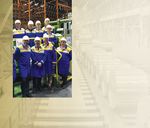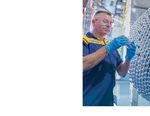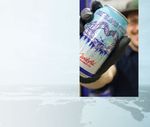BALL CORPORATION 2018 Sustainability Report
←
→
Page content transcription
If your browser does not render page correctly, please read the page content below
TABLE OF ABOUT OUR
CONTENTS REPORTING
CEO PERSPECTIVE 01 This is Ball Corporation’s sixth biennial sustainability report, covering calendar years 2016 and 2017.
It complements our financial reporting and covers the sustainability topics identified by Ball and our
BALL OVERVIEW 02 stakeholders as most material to our company. Customers, investors, employees and suppliers are
the primary audience for our reporting.
CIRCULAR ECONOMY 04
Unless otherwise stated, we are reporting sustainability metrics globally covering facilities where
CLIMATE CHANGE 14 Ball has operational control, which includes owned and leased manufacturing facilities, major
administrative offices, external warehouses, and research and development facilities. Operations
WATER STEWARDSHIP 22 that are outside of these criteria, such as joint venture locations where Ball does not have full
authority to introduce and implement its operating policies, are not included in our reporting.
RESPONSIBLE SOURCING 28
On June 30, 2016, Ball announced the completion of its acquisition of Rexam PLC and required
SUSTAINABILITY MANAGEMENT 34 divestitures, which resulted in significant changes to the company’s manufacturing footprint.
To ensure information and comparisons are reliable and meaningful over time, and to allow
DATA 36
stakeholders to perform consistent trend analyses of our sustainability performance over multiple
years, all 2010-2017 sustainability data included in our sustainability reporting is reflective of
Ball’s company footprint post-close of the Rexam acquisition. In addition to reporting Ball’s latest
EXTERNAL environmental performance data online, Ball annually updates historical environmental performance
ASSESSMENTS data as necessary if updated emission factors or more accurate activity data become available.
An external assurance statement by ERM Certification and Verification Services (ERM CVS) and
Ball’s sustainability management and performance further details on reporting principles, boundaries and data normalization are available on our
have again been recognized by external experts. website. Our reporting was developed in accordance with the Core level of the Global Reporting
Initiative (GRI) Standards. A detailed GRI Content Index appears online.
Throughout the online version of this report, click this symbol for additional web content.
CONTACT
We welcome your comments and questions on our sustainability efforts.
Please direct them to sustainability@ball.com.
More details on our sustainability performance, best practices and updates
on our progress are available at www.ball.com/sustainability.CEO PERSPECTIVE
When we closed on the Rexam acquisition they move through supply chains. From
in 2016, we pledged to leverage our a circular perspective, cans truly are the
larger scale to be more efficient and most sustainable package—economically
effective and to set new standards in and environmentally—relative to glass,
sustainable growth. As the market leader, plastic and other substrates. They are
we also committed to making Ball cans infinitely recyclable, easily collected and
the most sustainable package in the sorted, and are the package with by far
supply chain and, since then, have the highest economic value in the recycling
ramped up our efforts toward that stream. The global recycling rate for
goal in a meaningful way. aluminum beverage cans is 69 percent
and we know that there is still room for
I am often asked why we run a packaging
improvement. That is why we engage
and an aerospace business and how they
with customers, suppliers and other
are connected. Through the sustainability
partners around the world to establish
lens, this report provides one powerful
a more efficient collection and recycling
answer. Many of the innovative space
infrastructure, and to educate consumers
systems that Ball Aerospace builds
on why every can counts as well as the
support actionable environmental
many benefits of metal packaging recycling.
intelligence, and allow scientists and
other stakeholders to better understand We are also persistent in improving our
and address key sustainability challenges, operational sustainability performance
such as the circular economy, climate and throughout this report highlight the
change, water stewardship and ways in which we further increased energy
responsible sourcing. Our packaging and water efficiencies, decreased our
businesses contribute innovative and carbon intensity and optimized waste
sustainable packaging solutions, such management during the reporting period.
as our next generation STARcan and
Thank you to all of our employees,
our ReAL® aerosol technology, that
customers, suppliers and partners who
help address these challenges and
have contributed to our sustainability
help our customers reduce their
achievements so far. We look forward to
product carbon footprints.
future progress toward making the can the
Packaging is critical to delivering consumer most sustainable package and to delivering
John A. Hayes
products safely, conveniently and in good insightful environmental intelligence that will Chairman, President
condition, and it preserves and protects help ensure a successful future for all of us. & Chief Executive Officer
beverage, aerosol and other products as
CEO PERSPECTIVE 1BALL AEROSPACE
OVERVIEW BALL AEROSPACE IS A LEADER IN THE
DESIGN, DEVELOPMENT AND MANUFACTURE
OF INNOVATIVE AEROSPACE SYSTEMS FOR
CIVIL, COMMERCIAL AND NATIONAL CYBER
SECURITY AEROSPACE MARKETS.
FOUNDED CAPABILITIES
1880 SINCE
INSTRUMENTS & SENSORS
EMPLOYEES 1956
18,300 EMPLOYEES (YEAR-END 2017)
LINES OF BUSINESS TECHNOLOGIES & COMPONENTS 3,010
3 2017 NET SALES ($ IN MILLIONS)
2017 NET SALES ($ IN MILLIONS) $991
SPACECRAFT & SPACE SCIENCE
$10,983 LOCATIONS
MANUFACTURING 9
LOCATIONS (YEAR-END 2017)
ELECTRONIC WARFARE
90 ACTIVE IN
U.S.
ACTIVE IN
DATA ANALYTICS/ EXPLOITATION
NORTH &
CENTRAL AMERICA
SOUTH AMERICA ENGINEERING SERVICES
EUROPE
ASIA
TESTING
MIDDLE EAST
AFRICA
DRIVE FOR
WE KNOW... WHO WE ARE.
2 BALL CORPORATION
TENThe data captured through Ball-built GLOBAL BEVERAGE PACKAGING
instruments and satellites enables an
BALL IS THE WORLD’S LARGEST BEVERAGE CAN MAKER, SUPPLYING INNOVATIVE SUSTAINABLE PACKAGING
enhanced scientific understanding of
SOLUTIONS TO CUSTOMERS AROUND THE GLOBE.
major sustainability challenges, allowing
governments, industry and other
stakeholders to effectively address CAPABILITIES
these challenges.
SINCE CANS PRODUCED (2017)
BEVERAGE CANS
1969 100+ BILLION
CIRCULAR EMPLOYEES (YEAR-END 2017) ACTIVE IN
BEVERAGE ENDS 12,260
NORTH &
ECONOMY PAGE 04 CENTRAL AMERICA
2017 NET SALES ($ IN MILLIONS)
ALUMINUM BOTTLES $8,854
SOUTH AMERICA
EUROPE
MANUFACTURING
CLIMATE LOCATIONS (YEAR-END 2017)
69
ASIA, MIDDLE EAST, AFRICA
CHANGE PAGE 14
AEROSOL PACKAGING
WATER BALL IS THE WORLD’S LARGEST ALUMINUM SLUG AND IMPACT EXTRUDED AEROSOL CAN MANUFACTURER.
STEWARDSHIP PAGE 22 UNTIL JULY 31, 2018, THE COMPANY ALSO MANUFACTURED TINPLATE FOOD AND AEROSOL CANS IN THE U.S.
CAPABILITIES
SINCE CANS PRODUCED (2017)
AEROSOL CANS
RESPONSIBLE 1988 4.6 BILLION
EMPLOYEES (YEAR-END 2017) ACTIVE IN
SOURCING PAGE 28 SLUGS 2,705
NORTH &
CENTRAL AMERICA
2017 NET SALES ($ IN MILLIONS)
FOOD CANS & ENDS $1,138
SOUTH AMERICA
Ball’s packaging businesses face
four major sustainability challenges, MANUFACTURING
EUROPE
and are working on effective and LOCATIONS (YEAR-END 2017)
innovative solutions to turn them
ASIA
19
into business opportunities.
WHERE WE ARE GOING. WHAT IS IMPORTANT.
BALL OVERVIEW 3CIRCULAR ECONOMY BALL AEROSPACE INNOVATIVE SPACE SYSTEMS THAT SUPPORT ACTIONABLE ENVIRONMENTAL INTELLIGENCE In November 2017, Ball Aerospace was selected as the prime on sea surface temperature, another important element contractor by the U.S. Air Force to deliver the next-generation in determining ocean circulation. The National Oceanic and operational environmental satellite system, Weather System Atmospheric Administration (NOAA) will use this data in Follow-On-Microwave (WSF-M). Ball is responsible for developing its models. and integrating the entire microwave system, which includes the NOAA’s Marine Debris Program and scientists around the world microwave instrument, spacecraft and system software. continue to research and monitor marine debris and its impacts, This mission will improve weather forecasting over maritime and have found that many different ocean features can cause regions by taking global measurements of the atmosphere debris accumulation. and ocean surface. The system is designed to monitor ocean surface vector winds, tropical cyclone intensity and low Earth orbit energetic charged particles. Measurement of ocean surface wind speed and wind direction will help ocean models predict ocean surface currents. The system’s passive microwave radiometer will also provide data 4 BALL CORPORATION
A PLASTIC OCEAN
An estimated mere 5 percent of plastics are recycled effectively around the world,
while 40 percent end up in landfills and a third in fragile ecosystems such as the
world’s oceans.
Half of the world’s plastic ocean waste collects in five garbage patches. They do
not only consist of a layer of trash that floats at the surface, but are rather like soup
containing many minuscule suspended particles. In 2014, scientists determined that
5.25 trillion particles of “plastic smog” surface pollution, weighing 269,000 tons,
pollute our oceans worldwide. While larger items can threaten sea life such as turtles
and seals, which mistake plastic waste for food, microplastics can be digested by fish
and end up in the human food chain. The United Nations Environment Programme
conservatively estimated the economic costs of these externalities of plastic
packaging at $40 billion—exceeding the plastic packaging industry’s profit pool.
The North Pacific Subtropical
Convergence Zone concentrates
food sources for many species, but
also marine debris that comes ashore
on the Northwestern Hawaiian Islands.
The National Oceanic and Atmospheric
Administration (NOAA) and the Navy
will use this data in their ocean and
atmospheric prediction systems. SHIFTING PARADIGMS
The majority of corporate product stewardship strategies center around resource
efficiency, particularly in terms of lightweighting, sustainably produced materials,
recyclability and product carbon footprints. Metal packaging performs well in these
categories. For example, beverage cans are fully recyclable and the weight of
standard cans was reduced by up to 40 percent over the last 25 years.
CIRCULAR ECONOMY 5THE FACT THAT BEVERAGE
CANS HAVE THE HIGHEST
However, driven by a more informed recyclable. The truth is that recyclability
REAL RECYCLING RATE OF
and robust discussion around systemic is only an achievement when a product is
sustainability challenges and holistic consistently and infinitely recycled and the ALL BEVERAGE PACKAGING
product design, product stewardship material can be kept in the loop without
SUBSTRATES IS A GREAT
must move more quickly from small loss in material quality.
incremental changes on some isolated
For many products, technical capabilities
ACHIEVEMENT AND
issues to creating a circular economy.
Circularity is about retaining material
are insufficient to fully close the material REINFORCES THAT WE
loop and it is cheaper to use primary
value and complexity as much as possible
instead of recycled materials. Additionally, CORRECTLY PICKED THE
and for as long as possible—ideally without
any degradation. Instead of focusing on
significant losses in material quality and RIGHT SUBSTRATE WHEN
quantity still exist even in some established
making products as cheap as possible
recycling processes. Materials that lose WE FIRST INTRODUCED
and a little less harmful, products must be
some of their inherent properties when
designed so that they are recycled easily RED BULL BACK IN 1987.
recycled prohibit a truly circular economy.
and infinitely. In a truly circular economy,
product production costs, as well as all With permanent materials such as metals, WERNER DEPAULY
product life cycle-related costs, should the material’s inherent properties do not Global Head of Procurement and Sustainability
be considered. change during use or when repeatedly Red Bull
recycled into new products. Recycling
Full statement available online
CIRCULARITY BY DESIGN them does not necessarily require the
The old take, make, waste paradigm addition of primary material or other
has created products that are extremely additives to enable the basic material
cheap to produce yet very expensive to function and properties.
be recycled. Products made of only one
A circular economy strives to create
material or designed for easy disassembly,
favorable conditions for economically
do not require complex processing
viable recycling, rather than developing
before the materials are recycled.
lowest cost products that are not
Recyclability claims suggest that it is a
recycled and require expensive recycling
great achievement when a product is
6 BALL CORPORATIONtechnologies to be recovered. Instead
of trying to develop end-of-the-pipe
solutions, businesses must invest in
creating truly circular products in the
first place. During product design, the
following questions should be answered:
Are all materials used in a product
recyclable or only some?
Is a material actually recycled or
only collected for recycling then
sent to landfill?
Can the material be recycled infinitely
or is it only recyclable once or twice
before it becomes waste?
Is a product recyclable everywhere
or only in a laboratory set-up?
Is all of the input material available
as recycled output or is a significant
portion of the material lost
during recycling?
Is a product recycled into something
of similar value or is it downcycled into
a product of less value that might not
be recycled again?
ENVIRONMENTAL, SOCIAL, GOVERNANCE CRITERIA
Energy & Climate Water By-Products & Waste Land Use & Biodiversity Safety
Human Rights Labor Rights Business Integrity Transparency
CIRCULAR ECONOMY 7LIFE CYCLE THINKING larger. For example, can manufacturing Recycling reduces the energy needed for
makes up approximately one-fourth of primary metal production by 95 percent
Metal cans are produced using abundant
an aluminum beverage can’s energy for aluminum and 74 percent for steel,
materials. The earth’s crust consists of
consumption throughout its life. Most and cuts GHG emissions accordingly.
approximately 8 percent aluminum. It is
energy consumption and associated Some organizations promote recycled
the third most common element, while
greenhouse gas emissions occur during content as the solution for circularity.
iron is the fourth most plentiful element,
metal production, which our suppliers However, a product with high recycled
and metals have been recycled for as
continue to make more efficient. content that is not recycled is still an
long as they have been produced. In fact,
For example: example of a linear economy. For a
nearly 75 percent of all aluminum and
substrate like plastic with low economic
80 to 90 percent of all steel ever The carbon intensity of primary
scrap value, and where virgin material is
produced is still in use today. aluminum production in Europe
cheaper and easier to use than recycled,
decreased by 21 percent between
Packaging plays a critical role in introducing mandates on recycled content
2010 and 2015
delivering products to consumers could create the required end-market for
safely, conveniently and in perfect The energy needed to produce a recovered plastic.
condition. It protects and preserves food, metric ton of aluminum in the U.S.
For metals where recycling is economically
beverages and other products as they and Canada declined 26 percent
viable, there is no need to incentivize
move through supply chains. At Ball, between 1995 and 2010
recycled content through legislation
we evaluate products through a variety
or other mandates—the economics of
of lenses, including consumer benefits,
the material already drive recycling.
carbon footprints, costs and the impact
Additionally, by realizing the economic
on the recycling process. Life cycle
benefits, environmental savings are
thinking demands that our packaging be
achieved simultaneously. No matter the
considered in conjunction with the products
application for which recycled metal is
and embedded resources it protects.
used, metal recycling reduces the need for
While we continue to minimize the an equal amount of more energy-intensive
sustainability impacts of our operations, virgin metal.
those of our supply chain are significantly
8 BALL CORPORATIONBUSINESSES ARE STARTING
TO DEVELOP AMBITIOUS
ECONOMICS OF RECYCLING which is one reason why organizations SUSTAINABILITY TARGETS
involved in sorting and recycling are facing
While the materials used in certain
economic constraints today. Now is the AROUND MATERIALS
products have low, and in some instances
time to discuss what is actually recyclable,
no, value at the end of their useful life, MANAGEMENT—AND WITH
and what we as society and governments
metals have high economic value. At the
can afford to recycle. THEIR INNATE INNOVATION
end of 2017, for example, aluminum can
scrap from curbside collection in TOWARD 100% AND RESOURCEFULNESS,
California was worth eight times more RECYCLING RATES
THERE IS A NEW MOMENTUM
than PET, or four times as much on a A recent study confirmed that beverage
per container basis (with glass having cans have, by far, the highest global IN DEVELOPING SOLUTIONS.
no economic value). recycling rate of all common beverage WE NEED TO DO MORE,
While metal packaging represents a packaging substrates (69 percent).
small share of all household recyclables, Beverage can recycling rates are at or HOWEVER, TO TURN THIS
above 90 percent in several developed
it is a significant income for recyclers. In MOMENTUM INTO TANGIBLE,
the U.S., for example, aluminum packaging markets such as Belgium and Germany,
is estimated to be about 1 percent of the as well as in developing markets, such ON-THE-GROUND RESULTS.
recyclable waste stream of households as Brazil, where no formal packaging
by weight while representing 17 percent collection and recycling schemes yet exist. ERIN SIMON
of the value. Metals are subsidizing We believe that society and industry at Director, Sustainability R&D
packaging recycling systems, in particular large should aim for recycling rates close WWF
the collection and recycling of materials to 100 percent for all products. With that Full statement available online
with little or no economic value. goal in mind, all involved parties should
In many parts of the world, sorting collectively solve product design issues,
technologies and their deployment did not implement effective circular economy
keep up with the pace of change of the policies, and enhance collection and
recycling mix, increased contamination and recycling systems.
municipal recycling system modifications,
CIRCULAR ECONOMY 92017 COLLECTION & RECYCLING PROJECT HIGHLIGHTS
NORTH & CENTRAL AMERICA SOUTH AMERICA
The Recycling Partnership’s mission is to educate, inspire and empower One particular focus area for Ball is
stakeholders to strategically strengthen recycling in the U.S. Its broad promoting the importance of
spectrum of allied partners focus on driving quantity in the recycled waste pickers (catadores) as
materials stream. The partnership has reached more than 29 million environmental agents in Brazil.
households since 2014, supported more than 583 communities, That is why we support their
delivered more than 400,000 new recycling carts, achieved development through various
10-point reductions in targeted contamination rates, and diverted initiatives. For example, the
68,000 additional tons of recycled materials. This equates to avoiding Re-Circus program focuses
164,000 metric tons of GHG emissions, while adding jobs in the respective on promoting environmental
regions and building a pipeline of recovered materials for various industries. awareness and sustainability through
socio-cultural activities. In addition to attractions including
In 2017, The Recycling Partnership worked with the City of Denver, which is close to Ball’s
theatre performances, clowns and jugglers, lectures,
headquarters. Denver’s residential recycling program is already outperforming the national
storytelling and various workshops, the event also includes
average in terms of quality of material collected, but there is more material to be recovered.
collection points for recyclables that focus on leveraging
The goal of the three-month pilot was to find the best way to increase the amount of recyclables
waste sorting awareness.
that residents put in their recycling carts, starting with a focus on aluminum and steel cans. An
education program for 4,000 pilot households was implemented and on-the-ground recycling In 2017, Ball organized two Re-Circus events, one in Recife
experts tagged trash carts with an information card that instructed residents to put cans in their and one in Salvador, reaching 7,200 people. During the
recycling carts. Residents also received the message through mailers, signs and social media. event, Ball also supported the “Pimp my Cart”-initiative,
refurbishing 85 waste pickers’ carts and providing them
The pilot results were tremendous—the City of Denver saw a 25 percent increase in can recycling.
with personal protective equipment kits to improve health
As a result, Ball and other can makers are funding the city-wide roll-out (172,000 households)
and safety conditions.
of the campaign in 2018, which will again include capture rate studies to quantify the impacts
of the can-specific intervention. If the entire city could achieve the same results, an additional
225 metric tons of used beverage cans would be recovered, saving approximately 1,200 metric
tons of greenhouse gas emissions.
ALUMINUM BEVERAGE CAN RECYCLING RATES IN MAJOR MARKETS (latest available):
10 BALL CORPORATION Further recycling projects supported by Ball described onlineEUROPE AFRICA, MIDDLE EAST & ASIA
Every Can Counts (ECC) is working to encourage people to recycle beverage In the United Arab Emirates, Ball
cans they use when they are away from home—for example, at work and partners with the green non-
other “on the go” locations. ECC campaigns associate fun activities with governmental organization
can recycling to interact with consumers, festivals goers and the ones Emirates Environmental Group
who enjoy life in public spaces and want to make that extra sorting (EEG). In 2017, Ball became an
effort to save energy and valuable materials. official sponsor for EEG’s Can
Collection Drive. Under the motto
Originally developed in the U.K. to target the approximately 30 percent
“Small Actions, Big Impact,” Ball
of drinks cans used outside the home, ECC has successfully established
employees volunteered to join the
itself as the umbrella brand for promoting beverage can recycling away
EEG’s Can Collection Day in February and
from home, with programs running in 14 countries by early 2018, from Austria
October and supported a number of can collection activities.
to Benelux, Ireland, Scotland, Greece and Serbia. Exemplary success stories from 2017 include:
Having collected almost 10 metric tons of aluminum cans in
In Spain, Cada Lata Cuenta took part in urban culture festivals and a paragliding race
2017, and more than 300 tons since the program launch in
across the Pyrenees, went to colorful Mediterranean beaches and in the trendy design
1997, Ball and EEG plan to continue their close collaboration
street markets of Madrid. Among other events, ECC launched Pixelata 2.0 during the
by organizing new can recycling campaigns and awareness
Farcama festival in October 2017; where visitors became street artists, sprayed the bottom
raising sessions in schools throughout 2018. The partners
of cans consumed at the festival and created a giant piece of pixel art made of 2,000 cans.
have also kicked off a waste recycling awareness campaign
In the U.K., 2,454 sites had signed up for ECC in early 2018, creating more than 13,630 can across selected schools in the Emirates and placed beverage
collection points. ECC and Drops Cycling Team teamed up at cycling races during the 2017 can recycling bins on their grounds.
season. By racing against friends around an infinite recycling loop track, cycling enthusiasts
were engaged and encouraged to recycle more.
Since its inception in 2010, 2,217 participating sites across France and promotional activities
at 747 events contributed to Chaque Canette Compte’s success in reaching 14 million people
and collecting 57 million cans that were consumed away from home.
ALUMINUM BEVERAGE CAN RECYCLING RATES IN MAJOR MARKETS (latest available):
CIRCULAR ECONOMY 11We support policies which acknowledge important role in bringing this vision
that different substrates and combinations to life. We have considered ourselves
provide different enablers for a circular ambassadors for our products for
economy in terms of economic value, many years. For example, through
recyclability, avoidance of downcycling and employee donations and grants by
real recycling rates. Products that perform the Ball Foundation, we provided more
well in this regard already contribute to than $550,000 to recycling-related
the economic health of regional recycling projects around the world in 2017. In
systems. Products that do not yet qualify addition, U.S. employees logged more
as circular economy enablers should than 400 hours of volunteer time for
contribute their fair share to make the cleanups and educational programs.
system equitable and sustainable.
In 2017, we rolled out a Ball-wide
All stakeholders involved in packaging campaign called “Live the Can Life” to
collection and recycling, including material inspire employees to take additional steps
and packaging suppliers, consumer and proactively promote the economic,
brands, local governments, waste haulers environmental and social benefits of cans.
and recyclers, have a specific interest The campaign includes:
and, therefore, a role in helping improve
Key facts to help our employees talk
recycling rates. That is why we utilize
with family and friends about the
multi-stakeholder partnerships to enhance
can’s incredible sustainability story
packaging collection and recycling.
Education and advocacy information
18,300 EMPLOYEES about recycling in every region where
LIVING THE CAN LIFE we operate
On our journey to position the can as
Ways our employees can get
the most sustainable package in the
involved in promoting can use
beverage, food and aerosol supply
and can recycling
chains, every Ball employee plays an
12 BALL CORPORATIONOne aspect of Live the Can Life is OPTIMIZING WASTE STREAMS All of the metal scrap generated in
converting all Ball facilities and events IN OUR PLANTS our manufacturing is sent back to
into “can zones,” welcoming single-serve our suppliers and remelted so it can
Circularity also plays an important role in
aluminum and steel cans and avoiding be reused in new metal applications.
our manufacturing processes. Material
other substrates at our facilities or Ball- The remaining waste streams totaled
use and waste volumes are important
sponsored events. 72,683 metric tons globally in 2017,
yardsticks in evaluating the efficiency of
4 percent less than the total in 2016
In early 2018, we also launched the Ball our processes. Reducing spoilage and
and 17 percent less than in 2016 when
Recycling Can Challenge. By mobilizing our recycling all metal production scrap are the
compared per EVA® dollar generated.
employee base at all of our facilities around most obvious ways that Ball can conserve
We continue to educate our employees
the world and engaging them in local can resources and generate additional
about the benefits of recycling, provide
recycling initiatives, we strive to increase revenue. We focus on systematically
a convenient recycling infrastructure in
recycling rates, raise awareness about reducing the amount of waste generated,
our facilities and cultivate a conservation
the infinite recyclability of metal packaging increasing recycling rates and eliminating
mindset. While 63 percent of the total
and create a meaningful impact in the waste sent to landfills.
waste generated was reused or
communities where we operate.
recycled in 2017, only 13 percent
Through this competition, our facilities was sent to landfills. Thirty-nine of
can gain financial support for their internal our 88 packaging manufacturing
and external can recycling programs. plants worldwide achieved zero waste
By reaching out to, and working with, local to landfill status by year-end 2017.
community organizations and schools to
promote recycling, and focusing efforts
on capturing additional cans that would
otherwise not have been collected, we
create net economic, environmental and
social gains.
CIRCULAR ECONOMY 13CLIMATE CHANGE BALL AEROSPACE INNOVATIVE SPACE SYSTEMS THAT SUPPORT ACTIONABLE ENVIRONMENTAL INTELLIGENCE Climate change is a top concern around the world, and Scientists know that stratospheric ozone has some effect on the understanding weather and environmental impacts is critical. Ball world’s climate, and the world’s climate affects ozone distribution Aerospace helps monitor key atmospheric constituents such as ash, and concentration. However, these interactions are not well smoke and aerosols with long-term effects to life on Earth, including understood because the long-term data record of stratospheric the stratospheric ozone layer, which acts as a shield that protects us ozone is relatively short, on a climate scale. That is why space-based from the sun’s harmful radiation. measurements of ozone, from systems like OMPS, are so critical Ball supports the U.S. government’s obligation to monitor to continuing the global data record of ozone to help us better stratospheric ozone depletion under the 1987 Montreal Protocol—an understand the processes that impact our climate. international agreement to ensure there are no gaps in the protective layer of ozone that surrounds the Earth—with its Ozone Mapping and Profiler Suite (OMPS). This instrument measures how ozone concentration varies with altitude, while helping forecasters predict extreme wind events, track the migration of smoke, pollution, volcanic ash and meteor debris, and helps scientists better understand our dynamic planet. 14 BALL CORPORATION
OVERVIEW OF BALL’S CARBON FOOTPRINT
In 2017, Ball emitted 1.4 million metric tons of greenhouse gas (GHG) emissions—
directly by burning fossil fuels such as natural gas and diesel on site (Scope 1),
and indirectly by consuming purchased electricity, heat or steam generated off
site (Scope 2). Compared to 2016, Ball reduced the absolute amount of these
GHG emissions by 2 percent.
In addition, we caused 13.2 million metric tons of indirect GHG emissions in 2017
(Scope 3). These emissions occurred in our value chain, including both upstream and
downstream, from sources not owned or directly controlled by Ball, but related to our
activities. Eighty-five percent of these emissions stem from the metals we purchased.
Ensuring our stakeholders understand our commitments and how we contribute
to our customers’ sustainability targets requires a high level of transparency of our
sustainability performance, including organizational and product carbon footprints.
To ensure the accuracy and reliability of our data, we engaged ERM Certification and
Verification Services to provide limited assurance in relation to our 2017 GHG emissions
(Scope 1, 2 and 3).
TOTAL 2017
The smoke from December 2017 wild GHG EMISSIONS (SCOPE 1,2 &3):
14.6 MILLION TONS C02e
fires in Southern California impacted
the west coast of the U.S. and Canada.
The OMPS instrument captures the
aerosol index, showing concentrations
of atmospheric constituents, such as
smoke and ash, making its way north.
1
overs capital goods, fuel- and energy-related activities (not in scope 1+2), waste from our sites, processing of
C
sold products, investments; end-of-life treatment of our products is accounted for under metals.
CLIMATE CHANGE 15TOGETHER WITH BALL, THE
WORLD’S LEADING BEVERAGE
TRANSITIONING TO By 2030, we will reduce our CAN MANUFACTURER AND
A LOW CARBON ECONOMY absolute Scope 1 and 2 GHG
emissions by 27 percent against STRATEGIC GLOBAL SUPPLIER
For 15 years, Ball has utilized a Carbon
Intensity Index (CII) that is calculated based
a 2017 baseline. Per million dollars TO AB INBEV, WE WILL WORK
of value added, this equates to a
on the total GHG emissions (Scope 1 and
56 percent reduction of our carbon CLOSELY TO FURTHER INCREASE
2) of each business in which we operate,
intensity over the same period.
normalized by a denominator specific to RECYCLING RATES FOR USED
each business. The normalization factor In addition, Ball strives to reduce GHG BEVERAGE CANS AROUND THE
is a weighted approach based on the emissions across the value chain—from
differing intensities of production/sales mining, refining, smelting, casting and
WORLD, PURSUE ACCELERATED
in the base year. It accounts for overall rolling, to Ball’s manufacturing, logistics, CAN LIGHT-WEIGHTING, AND
production changes over the goal period, and end-of-life recycling— per can
and for changes in production mix between produced by 25 percent over the SEEK EFFICIENCIES IN LOGISTICS
the various business segments. same period. AND PRODUCTION THROUGHOUT
In the past, we committed to 10- and
5-year CII reduction targets (2002-2012 At the time of this report’s publication, OUR JOINT VALUE CHAINS.
and 2010-2015), which were achieved on we were in the process of submitting our
or ahead of time (2010, 2015). At the end target for approval by the Science Based TONY MILIKIN
Targets initiative.
of 2017, Ball had achieved a 23 percent Chief Procurement and Sustainability Officer
reduction in our CII from a 2010 baseline, We follow a three-pronged approach Anheuser-Busch InBev
averaging a 3 percent reduction per year to achieve our targets: Full statement available online
(see page 36 for detailed data).
Increase efficiency: save energy
To help tackle climate change, Ball set a and materials
bold new science-based greenhouse gas
Grow renewables: purchase
emission reduction target, in line with the
renewable energy
level of decarbonization required to keep
the average global temperature increase Cut embedded carbon: work
below 2 degrees Celsius compared to with partners to reduce
pre-industrial temperatures: upstream impacts
16 BALL CORPORATIONTo successfully transition to a low carbon focused on global operational metrics plant, air compressors consume between
economy, position cans as the most and achieving our sustainability goals. 20 and 30 percent of the electricity.
sustainable package and achieve our We conduct audits of our compressed
Our Global Beverage Packaging business
Drive for 10 vision, we must provide an air systems and optimize performance
accounted for 85 percent of our total
inclusive workplace and promote diversity by reducing system pressure, minimizing
energy consumption of 4.5 million
to foster creativity and innovation. With wasteful air use and leaks, and decreasing
megawatt hours in 2017. Measured per
different perspectives come different manufacturing equipment demand.
unit of production, energy efficiency in
solutions to help our customers and We continued to install more efficient
this business has improved 3 percent
our business succeed. compressors and connected additional
since 2015 (see page 36 for detailed
equipment to low-pressure systems
SMART ENERGY USE data). Opposing trends such as increasing
during the reporting period. At the end
varieties of can sizes, shapes and labels,
By using energy more efficiently, we reduce of 2017, 55 percent of our beverage can
resulting shorter production runs, line
our operating costs and GHG emissions. plants operated dual-air systems that
or plant curtailments, and new line
Every Ball plant commits to annual energy supply equipment with either high- or
startups, can offset progress toward our
goals supported by detailed action plans. low-pressure air. Compared to traditional
energy efficiency goals. To manage these
Real-time energy information systems systems that rely only on high pressure,
challenges effectively, we continuously
provide higher visibility into our operations low pressure compressed air is 22 percent
invest in our businesses. In 2016/2017,
at the equipment level so we can better more energy efficient than high pressure
we invested $11 million in energy efficiency
understand, manage, report on and air, and also results in less energy loss
measures. These projects are expected to
benchmark the performance of energy- through artificial demand.
deliver electricity savings of approximately
consuming processes. At year-end 2017,
34 million kilowatt hours, and natural Within our operations, ovens are used
22 plants had comprehensive energy
gas savings of 4 million kilowatt hours, to evaporate water from cans after being
monitoring systems in place and we plan
resulting in 9,900 metric tons less of washed and to cure external and internal
to add them in all global beverage plants
GHG emissions. coatings. Ovens account for up to
by 2021.
75 percent of a beverage can plant’s
From employee engagement to machinery
To leverage our engineering talent around natural gas usage and up to 20 percent
and equipment, heating and cooling, heat
the world, our Global Beverage Packaging of its electricity usage. Through oven
recovery, lighting and energy management,
business created a global engineering audits, low-cost optimization projects,
we focus on various energy-saving
organization in 2017. The new team is and increased employee awareness of
opportunities. The majority of our energy
developing a platform and processes oven energy use and associated costs, we
consumption comes from air compressors
to identify and exchange best practices have realized natural gas efficiency gains
and ovens in our plants. In a beverage can
CLIMATE CHANGE 17in our can businesses of 9 percent we realize annual electricity savings is Ball’s most metal-efficient can.
between 2012 and 2017. of approximately 5 million kilowatt Together with our customers we can
hours, equivalent to 890 metric tons jointly drive towards a new standard of
During the reporting period, lighting
of GHG emissions. performance and the achievement of
continued to be a priority for our energy
key sustainability objectives. If we were
engineers. While it is crucial to provide STAR: NEXT GENERATION CANS
to switch our entire production volume
proper lighting to keep our employees
Weight optimization of our cans contributes of 33-centiliter and 12-ounce standard
safe and allow them to effectively
significantly to reducing our carbon cans to the STAR format with a weight
execute their jobs, lights do not need to
footprint. The less metal we use per well below 10 grams, we would save
be continually at full power. Every Ball
container, the smaller the amount of approximately 30,000 metric tons of metal,
plant changed some lighting to LED and
embedded carbon. We intend to make or the equivalent to nearly 200,000 metric
several underwent complete conversions.
the lightest possible metal containers while tons of GHG emissions. We plan to roll
We include adaptive lighting control options
meeting our customers’ performance out the STARcan in other sizes around
to further increase efficiency by matching
requirements. Weight optimization is also the world in the future as well.
the light levels to occupancy and daylight
a key contributor to our customers’ value
availability. Compared to conventional
chain carbon footprint reduction efforts.
A NEW ERA FOR RENEWABLES
lighting, a completely converted LED plant
By year-end 2017, we installed three
with both lights and respective controls Weight optimization saves significant
1.5-megawatt windmills at our Findlay,
saves about 75 percent lighting electricity, metal, costs, energy and emissions when
Ohio plant and purchased green electricity
with 55 percent of this savings from the multiplied by the more than 100 billion
at two European sites. The GHG emissions
LED and 45 percent from the controls. cans Ball produces each year. Through
saved through these projects equals more
In addition to LED lighting, we are installing lightweighting, we reduced aluminum use
than 25,500 metric tons. Since January
skylights and additional windows in some in our beverage and aluminum aerosol
2018, we also converted one of our
of our facilities to better utilize daylight. packaging businesses by 7,700 metric
Scandinavian plants to biogas. In addition
tons in 2017, which equates to saving
Line control optimization provides another to delivering on emission reduction goals
58,000 metric tons of GHG emissions,
opportunity for efficiency gains. When and showing leadership on climate change,
or the emissions of 12,400 U.S. passenger
production stops for short periods of time, green power can also help manage
vehicles per year.
for example during a label change, not all fluctuating energy costs, create jobs in local
equipment needs full power. By installing In 2017, we launched STARcan, a next economies, improve reputation and provide
variable frequency drives (VFDs), we slow generation beverage can, which leverages energy security.
or shut down certain systems to realize technology and our weight optimization
Building on the positive initial experiences
energy savings. By installing VFDs in 11 of know-how. Initially available in Europe
with small-scale renewable energy, Ball
our South American plants during 2017, on 33- and 50-centiliter cans, STARcan
joined the Rocky Mountain Institute’s
18 BALL CORPORATIONSUSTAINABLE GREENFIELD PLANTS
Throughout 2017, Ball teams were building greenfield
plants in Goodyear, Arizona (U.S.) and near Madrid, Spain.
From the beginning, the vision for both facilities was to
make them state-of-the-art, sustainable beverage can
manufacturing plants.
In Goodyear, Ball implemented a new lighting concept. Next
to plant-wide LED lights with adaptive controls, we installed
210 prismatic skylights and additional windows, allowing us
to turn off most high bay lights during the day. From ovens
to compressed air and vacuum pumps, all equipment was
engineered for adaptive demand, minimizing energy and
water consumption during downtimes. Due to the hot
Arizona climate, we implemented multiple measures to
minimize the building’s internal heat gain, including the
installation of water-cooled compressors.
In Spain, we paid special attention to the design of the
compressed air systems: high- and low-pressure compressed
air systems, fed by energy efficient compressors with
filtration and air leader control systems will simultaneously
reduce energy usage and maintenance costs. This plant will
be one of the most sustainable can plants with heat recovery,
adaptive control systems for vacuum and compressed Contributing to the UN Sustainable Development Goals:
air, plant-wide LED lighting, ultra-efficient burners on all
ovens that save 16 percent of the natural gas compared
to standard ovens, and will manufacture the lightest
33-centiliter can body in our European system.
CLIMATE CHANGE 19WE REDUCED OUR CARBON
DIOXIDE EQUIVALENT EMISSIONS
Business Renewables Center (BRC) in our value chain emissions, develop INTENSITY BY 46.5 PERCENT
2017. The BRC platform streamlines reduction plans and engage value chain
and accelerates corporate purchasing partners in meaningful mitigation actions. BETWEEN THE 2005 BASELINE
of off-site, large-scale wind and solar Ball evaluated Scope 3 emissions from AND 2017. IN 2018, ALCOA
energy, making it easier for us to enter 15 categories covering upstream emissions,
the renewable energy market by like those embedded in the products and AND RIO TINTO ANNOUNCED
learning from the first movers. services we purchase, and downstream
ELYSIS—A REVOLUTIONARY
emissions, for example from shipping our
As a next step on our renewables
products to our customers. PROCESS TO MAKE ALUMINUM
journey, we established a cross-functional
renewables team at Ball and engaged While we continuously seek to optimize THAT PRODUCES OXYGEN
a third-party renewable energy consultant logistics, generate less waste and reduce
in 2017 to explore opportunities to cover business travel—which will reduce our
AND ELIMINATES ALL DIRECT
a significant portion of our North American Scope 3 emissions—we focus our efforts GREENHOUSE GAS EMISSIONS
electricity load with renewables. We are on the carbon embedded in the metals
focusing on North America first because we purchase. Of our 2017 Scope 3
FROM THE TRADITIONAL
52 percent of our 2017 global electricity emissions, 11.3 million metric tons are SMELTING PROCESS.
load and 62 percent of our Scope 2 GHG related to metals, with 93 percent
emissions come from North America, stemming from aluminum and ROSA M. GARCIA PIÑEIRO
and due to the favorable energy market 7 percent from tinplate steel.
Vice President, Sustainability
conditions in that region. We expect to
Primary aluminum produced in Europe Alcoa Corporation
conclude the project selection process
generated 21 percent fewer GHG emissions Full statement available online
in the second half of 2018 and then
per ton produced in 2015 compared to
explore further opportunities in Europe
2010. The rolling-mill process also became
and other regions where it makes
25 percent less carbon intensive during
economic and environmental sense.
that same period. In North America, the
GHG EMISSIONS ALONG carbon footprint of primary aluminum
THE VALUE CHAIN production was reduced by 37 percent
per ton of aluminum between 1995 and
Detailed insights into our Scope 3
2010—with 75 percent of the electricity
emissions allow us to identify relevant
required for aluminum production coming
risks and opportunities associated with
from hydropower.
20 BALL CORPORATIONTo continue this successful track record that are tied to mitigating the causes donations on an ongoing basis in
and achieve additional substantial GHG and consequences of climate change advance of major disasters to help the
emission reductions, the metal industry to increase recycling rates, prepare for Red Cross ensure an immediate response
will need to maintain its focus on and respond to disasters, and support to meet the needs of those affected
technology transfer, cross-industry Science, Technology, Engineering by disasters of all sizes, at no cost and
collaboration and breakthrough and Math (STEM) education. regardless of income. In December 2017,
technologies. To support these efforts, we for example, a series of wildfires ignited
Global support in 2017 included more
partner with our strategic metal suppliers across Southern California (pages 14-15)
than 38,000 volunteer hours and
and exchange perspectives around how and led to the evacuation of more than
$5 million, plus in-kind product donations
to further reduce the embedded carbon 230,000 people and significant property
for disaster relief. In partnership with our
of metals (pages 28-33). losses. The fires, which were exacerbated
customers, Ball also donated millions
by large amounts of dry vegetation due
Recycling metals reduces the need to of cans for drinking water that assisted
to an unusually dry rainy season, burned
utilize more energy-intensive virgin metal. massive disaster relief efforts in Mexico,
more than 1,200 square kilometers and
Recycling aluminum saves 95 percent of Puerto Rico and in several U.S. states.
caused hazardous air conditions and
the energy needed for primary production,
When disaster threatens or strikes, the power outages. Leveraging cash and
and an equivalent amount of GHG
International Federation of Red Cross in-kind support from employees and The
emissions. We estimate that more than
and Red Crescent Societies provides Ball Foundation, Ball partnered with the
half of the aluminum Ball consumed in
shelter, food, and physical and emotional American Red Cross to help support work
2017 was made from recycled material.
health services to address basic human of the disaster responders, making sure
However, we focus all our efforts on
needs and assist individuals and families those affected had a safe place to stay,
increasing the recycling rates of our
to resume independence and normal food to eat and a shoulder to lean on.
products—because only a product that is
daily activities. The Ball Foundation has
recycled at the end of its useful life enables
supported the American Red Cross
climate protection and a circular economy
since 2012 and Ball launched a global
(pages 4-13).
partnership with the International
EXPANDING DISASTER Federation of Red Cross and Red
RELIEF SUPPORT Crescent Societies in 2017 to help
fund disaster relief all over the world.
Ball and its employees are continuing
their strong support of local communities As a member of the Red Cross’ Disaster
worldwide through a range of activities Responder Program, Ball pledges
CLIMATE CHANGE 21WATER STEWARDSHIP BALL AEROSPACE INNOVATIVE SPACE SYSTEMS THAT SUPPORT ACTIONABLE ENVIRONMENTAL INTELLIGENCE Freshwater makes up less than 1 percent of the Earth’s total water. measurements in NASA’s GPM Scientists from around the world are studying how precipitation, constellation. GMI’s high frequency climate and weather affect the availability of our water resources, channels measure small particles of ice, snow especially in the context of climate change. and rain while the JAXA-built Dual-Frequency The Global Precipitation Measurement (GPM) mission, a joint effort Precipitation Radar (DPR) instrument gives a 3D view of between NASA and the Japan Aerospace Exploration Agency a column of precipitation. Together, these instruments give (JAXA), is improving understanding of precipitation patterns scientists an unprecedented view of small precipitation around the world. GPM provides data about Earth’s water and particles with a much higher degree of accuracy. energy cycles, improves forecasting of events that cause natural disasters, and extends current capabilities for using highly accurate precipitation data. Ball Aerospace designed, developed and fabricated the GPM Microwave Imager (GMI). The highly accurate GMI instrument now serves as a reference standard for calibrating precipitation 22 BALL CORPORATION
THE WATER-ENERGY-CLIMATE NEXUS
Water is one of our planet’s most important natural resources. A growing world
population with greater demands for water-intensive food and energy, combined
with changing ecosystems and severe pollution of water resources in some
regions, can pose significant water supply constraints. At Ball, we recognize
that water-related challenges can pose major business risks, yet, when well
managed, they provide opportunities for improvement and innovation.
Because access to fresh water is vital to consumers, our customers, suppliers
and Ball, we hold ourselves accountable for conserving and protecting water
resources in our manufacturing plants, the communities where we operate, and
along our entire value chain. As our company continues to transform, we are
evaluating our resource and operational footprint and the associated risk factors
to establish a Global Water Framework. This framework will formalize our global
water stewardship efforts and outline a clear strategy for further engagement
and conservation.
On August 25, 2017, GPM provided a ORGANIZATIONAL WATER FOOTPRINT
three-dimensional view of Hurricane Our number one measure to protect water resources is using as little as
Harvey’s heavy rainfall. GMI peered possible for each product we produce. In 2017, Ball used 9.7 million cubic
through dense storm clouds to reveal meters of water worldwide, primarily for forming, washing, rinsing and cooling.
the location of intense rainfall bands Our global beverage packaging business, which accounted for 94 percent of
the total, improved water efficiency by 8 percent during 2016 and 2017.
near the center of the hurricane. GMI
We continue implementing projects to better understand and manage
data indicated that powerful storms in
regional and local water impacts (see page 36 for detailed data).
the hurricane were dropping rain at a
Ball’s most water-intensive process is washing our cans during
rate of more than 2.1 inches per hour.
manufacturing. On average, washers account for about two-thirds of
(Credits: NASA/JAXA)
the total water consumption in a beverage can plant. To create efficiencies,
Ball’s washer process occurs in counter-current cascades to reuse water at
different washing stages. More than 90 percent of the water we use in our
can plants returns to the watershed after treatment, with the remainder
primarily evaporating.
WATER STEWARDSHIP 23OUR GLOBAL TEAM OF WATER
ENGINEERS IS LEADING EXCITING
Our beverage packaging business To better understand, monitor and improve TECHNOLOGY TRIALS AND WE
implemented a global operating model our water usage, Ball continues to invest in
in 2017 to leverage our scale and to water monitoring equipment such as flow REVIEW AND COMPARE IMPACTS
strategically utilize our resources and meters. In fact, the majority of washers in AND REMAINING CHALLENGES
assets. At that time, we created a global our North and South American, and our
operations and engineering function, European beverage can businesses are OF THESE TECHNOLOGIES AND
and formed a washer team comprised equipped with electronic water meters.
THEIR APPLICABILITY ACROSS
of water engineers from Ball’s five regions. Enhanced water monitoring increases
The team works collaboratively with the aim the visibility of water consumption, OUR PLANT PORTFOLIO ON A
of helping to deliver our water reduction fosters employee awareness and
REGULAR BASIS.
targets through benchmarking, best enables us to better understand and
practice sharing and process innovation. optimize our systems. We are also mapping
HUMBERTO DARLIM
Additionally, the global innovation team interdependencies between our water and
is challenging conventional thinking and energy usage. For example, more energy Chemical Process Manager
examining breakthrough technologies that efficient compressors generate less waste Ball Beverage Packaging Europe
will allow us to change how and how much heat resulting in less water evaporation in Full statement available online
water we use in our operations. cooling towers.
Multiple plants have appointed local water We continue to enhance wastewater
champions who analyze water data, control treatment technologies, evaluate advanced
water-consuming equipment and drive treatment options for effluents and install
enhancements. We conducted an extensive pilot systems to enable water reuse. For
water usage survey during the reporting example, in one of our European plants,
period to evaluate the water stewardship we are piloting a Zero Liquid Discharge
culture that these champions foster, actual (ZLD) system, an industrial wastewater
data and process controls. The survey treatment system developed to completely
helped us determine best practices and eliminate all liquid discharge. The main
key success factors that reduce water purpose of ZLD is to recover treated water
usage. Based on the learnings, we so the washers can reuse it continuously,
defined criteria for future washer rebuilds subsequently reducing water usage by
and shared successes with the global team. as much as 90 percent.
24 BALL CORPORATIONDuring 2017, 49 percent of our WATER IN OUR VALUE CHAIN The same principles apply to the products
88 manufacturing plants optimized that fill our cans. With beer, for example,
Water is crucial in aluminum production
water efficiency, with 16 percent improving water footprint studies indicate that one
and can manufacturing. It is also a
by 10 percent or more, through a variety of liter of beer produced in, and with
primary ingredient in our customers’
projects: flow meters, training and building a majority of agricultural ingredients
products, from growing crops such
awareness, washer audits, process water from, the Czech Republic has a total
as barley, hops and sugarcane, to the
pre-treatment, minimizing washer drag water footprint of 45 liters. In South
actual drinks manufacturing, which is
out volumes while optimizing counterflow Africa, it is 155 liters. The difference
why we maintain an open dialogue
efficiencies, installing new coalescers to is driven primarily by the evaporative
with our suppliers, customers and the
better separate oil and water that can be demand for crops due to meteorological
communities where we operate.
repurposed, and developing models to conditions and the reliance on irrigated
determine contamination profiles based According to data by the International crops in some regions. Per 12-ounce can,
on various parameters such as can type Aluminum Institute, about 16 cubic meters metal production uses approximately
and line speed. In our Vsevolozhsk, Russia, of fresh water and 11 cubic meters of 12 times more water (1 liter) compared
plant, we also installed a new rainwater sea water are consumed per metric ton to can manufacturing (86 milliliters).
harvesting system that contributes to the of aluminum ingot produced. Water is The combined water footprint of these
plant successfully cutting their normalized used to process bauxite, manage dust processes is 14 times smaller than the
water usage in half within two years. emissions, generate hydroelectric power footprint of the beer the can contains—
and for cooling. The rolling process when considering that ingredients come
consumes another 7 cubic meters of from a region with favorable crop
water on average. The environmental water consumption.
impacts associated with these uses vary
UNDERSTANDING
significantly and must be evaluated in
WATER-RELATED RISKS
terms of their relative contribution to
water scarcity in the respective region, Water scarcity, quality and discharge are
as well as the extent to which water operational and reputational risks for Ball
discharge differs from the intake as far and our value chain partners. Flooding is
as temperature, effluents and the total an example of our physical water-related
amount are concerned. risks (see case study). Water scarcity
caused by drought or user over-allocation,
WATER STEWARDSHIP 25You can also read



























































